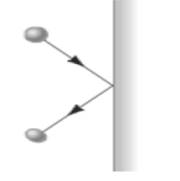
(a)
The direction of the change in momentum of the ball.
(a)
Answer to Problem 13Q
Direction of the vertical component of momentum will remain unchanged that is in the downward direction. Direction of the horizontal component will be reverse that isit will have a negative x -component.
Explanation of Solution
Introduction:
According to the law of conservation of momentum, momentum before and after the collision must remain equal.
A ball is coming from the upward direction making an angle of

Thus, the ball will make two components, one in vertical and another in the horizontal direction. Now, because the ball is moving in the downward direction, vertical component will remain unchanged as shown in the figure.
Perhaps, incase of horizontal direction, as the wall is on the right side of the incoming ball. Thus, wall will not move back. But, will exert an opposite force on the ball to fall back making the same inclination. Thus, the ball will move in the left direction. So, direction of the horizontal component momentum will be reverse that isit will have a negative x -component.
(b)
The direction of the force on the wall.
(b)
Answer to Problem 13Q
Direction on the force of the wall will be inpositive x -direction.
Explanation of Solution
Introduction:
According to the law of conservation of momentum, momentum before and after the collision must remain equal.
A ball is coming from the upward direction making an angle of

Since the ball is colliding with the wall making an angle of
Conclusion:
In the right direction (positive x -direction), force will be applied to the wall.
Chapter 7 Solutions
Physics: Principles with Applications
Additional Science Textbook Solutions
University Physics Volume 2
Physics (5th Edition)
Essential University Physics: Volume 2 (3rd Edition)
Physics for Scientists and Engineers with Modern Physics
 College PhysicsPhysicsISBN:9781305952300Author:Raymond A. Serway, Chris VuillePublisher:Cengage Learning
College PhysicsPhysicsISBN:9781305952300Author:Raymond A. Serway, Chris VuillePublisher:Cengage Learning University Physics (14th Edition)PhysicsISBN:9780133969290Author:Hugh D. Young, Roger A. FreedmanPublisher:PEARSON
University Physics (14th Edition)PhysicsISBN:9780133969290Author:Hugh D. Young, Roger A. FreedmanPublisher:PEARSON Introduction To Quantum MechanicsPhysicsISBN:9781107189638Author:Griffiths, David J., Schroeter, Darrell F.Publisher:Cambridge University Press
Introduction To Quantum MechanicsPhysicsISBN:9781107189638Author:Griffiths, David J., Schroeter, Darrell F.Publisher:Cambridge University Press Physics for Scientists and EngineersPhysicsISBN:9781337553278Author:Raymond A. Serway, John W. JewettPublisher:Cengage Learning
Physics for Scientists and EngineersPhysicsISBN:9781337553278Author:Raymond A. Serway, John W. JewettPublisher:Cengage Learning Lecture- Tutorials for Introductory AstronomyPhysicsISBN:9780321820464Author:Edward E. Prather, Tim P. Slater, Jeff P. Adams, Gina BrissendenPublisher:Addison-Wesley
Lecture- Tutorials for Introductory AstronomyPhysicsISBN:9780321820464Author:Edward E. Prather, Tim P. Slater, Jeff P. Adams, Gina BrissendenPublisher:Addison-Wesley College Physics: A Strategic Approach (4th Editio...PhysicsISBN:9780134609034Author:Randall D. Knight (Professor Emeritus), Brian Jones, Stuart FieldPublisher:PEARSON
College Physics: A Strategic Approach (4th Editio...PhysicsISBN:9780134609034Author:Randall D. Knight (Professor Emeritus), Brian Jones, Stuart FieldPublisher:PEARSON





